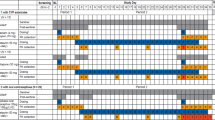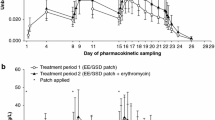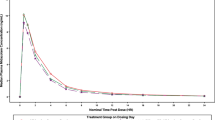Abstract
Purpose
To assess drug–drug interactions of fesoterodine with cytochrome P450 (CYP) 3A4 inhibitor (ketoconazole), inducer (rifampicin), and substrates (ethinylestradiol and levonorgestrel).
Methods
Effects of ketoconazole 200 mg twice daily and rifampicin 600 mg twice daily on fesoterodine 8 mg once daily were investigated in CYP2D6 extensive metabolizers (EMs) and poor metabolizers (PMs) based on 5-hydroxymethyl tolterodine (5-HMT) pharmacokinetics (principal active fesoterodine metabolite and CYP3A4 substrate). Effects of fesoterodine 8 mg versus placebo once daily on ethinylestradiol and levonorgestrel were investigated based on oral contraceptive pharmacokinetics and on pharmacodynamic effects on progesterone, luteinizing hormone, follicle-stimulating hormone, and estradiol plasma levels.
Results
Compared with fesoterodine alone, coadministration of fesoterodine with ketoconazole resulted in increases in mean 5-HMT maximum concentration in plasma (Cmax; from 3.0 to 6.0 ng/mL in EMs and from 6.4 to 13.4 ng/mL in PMs) and mean area under the plasma concentration time curve (AUC; from 38.2 to 88.3 ng h/mL in EMs and 88.3 to 217.2 ng h/mL in PMs). Coadministration of festerodine with rifampicin resulted in decreases in mean 5-HMT Cmax (from 5.2 to 1.5 ng/mL in EMs and from 6.8 to 1.9 ng/mL in PMs) and mean AUC (from 62.4 to 14.4 ng h/mL in EMs and from 87.8 to 19.6 ng h/mL in PMs). Fesoterodine did not affect oral contraceptive pharmacokinetics or pharmacodynamics or the suppression of ovulation.
Conclusions
Fesoterodine dosage should not exceed 4 mg once daily when taken concomitantly with potent CYP3A4 inhibitors. Coadministration of CYP3A4 inducers with fesoterodine may produce subtherapeutic 5-HMT exposures. No dose adjustment is necessary for concomitant use of fesoterodine with oral contraceptives.




Similar content being viewed by others
References
Abrams P, Artibani W, Cardozo L et al (2006) Reviewing the ICS 2002 terminology report: The ongoing debate. Neurourol Urodynam 25:293
Abrams P, Cardozo L, Fall M et al (2003) The standardisation of terminology in lower urinary tract function: report from the standardisation sub-committee of the International Continence Society. Urology 61(1):37–49
Wein AJ, Rackley RR (2006) Overactive bladder: a better understanding of pathophysiology, diagnosis and management. J Urol 175(3 Pt 2):S5–S10
Stewart WF, Van Rooyen JB, Cundiff GW et al (2003) Prevalence and burden of overactive bladder in the United States. World J Urol 20(6):327–336
Irwin DE, Milsom I, Hunskaar S et al (2006) Population-based survey of urinary incontinence, overactive bladder, and other lower urinary tract symptoms in five countries: results of the EPIC study. Eur Urol 50(6):1306–1315
Andersson K-E (2004) Antimuscarinics for the treatment of overactive bladder. Lancet Neurol 3(1):46–53
Michel MC (2008) Fesoterodine: a novel muscarinic receptor antagonist for the treatment of overactive bladder syndrome. Expert Opin Pharmacother 9(10):1787–1796
Malhotra BK, Guan Z, Wood N et al (2008) Pharmacokinetic profile of fesoterodine. Int J Clin Pharmacol Ther 46(11):556–563
Nilvebrant L (2001) Clinical experiences with tolterodine. Life Sci 68(22–23):2549–2556
Cole P (2004) Fesoterodine, an advanced antimuscarinic for the treatment of overactive bladder: a safety update. Drugs Future 29(7):715–720
Xie HG, Kim RB, Wood AJ et al (2001) Molecular basis of ethnic differences in drug disposition and response. Annu Rev Pharmacol Toxicol 41:815–850
Toviaz (fesoterodine fumarate) (2007) Full prescribing information. Pfizer, New York
Davis PJ, Stiller RL, Wilson AS et al (2002) In vitro remifentanil metabolism: the effects of whole blood constituents and plasma butyrylcholinesterase. Anesth Analg 95(5):1305–1307 (table of contents)
Rosow CE (1999) An overview of remifentanil. Anesth Analg 89[4 Suppl]:S1–S3
Beers R, Camporesi E (2004) Remifentanil update: clinical science and utility. CNS Drugs 18(15):1085–1104
Charasson V, Bellott R, Meynard D et al (2004) Pharmacogenetics of human carboxylesterase 2, an enzyme involved in the activation of irinotecan into SN-38. Clin Pharmacol Ther 76(6):528–535
Fauci AS, Braunwald E, Kasper DL et al (2008) Harrison’s principles of internal medicine, 17th edn. McGraw-Hill, New York
Brynne N, Forslund C, Hallen B et al (1999) Ketoconazole inhibits the metabolism of tolterodine in subjects with deficient CYP2D6 activity. Br J Clin Pharmacol 48(4):564–572
Oesch F, Arand M, Benedetti MS et al (1996) Inducing properties of rifampicin and rifabutin for selected enzyme activities of the cytochrome P-450 and UDP-glucuronosyltransferase superfamilies in female rat liver. J Antimicrob Chemother 37(6):1111–1119
Kasper DL, Braunwald E, Hauser S et al (2004) Harrison’s principles of internal medicine, 16th edn. McGraw-Hill, New York
Olsson B, Landgren BM (2001) The effect of tolterodine on the pharmacokinetics and pharmacodynamics of a combination oral contraceptive containing ethinyl estradiol and levonorgestrel. Clin Ther 23(11):1876–1888
Acknowledgments
Funding for this study was provided by Schwarz Biosciences and Pfizer Inc. Editorial support was provided by Simon J. Slater, PhD, at Complete Healthcare Communications Inc, and was funded by Pfizer Inc.
Author information
Authors and Affiliations
Corresponding author
Additional information
Funding for this study was provided by Schwarz Biosciences GmbH, and Pfizer Inc.
Rights and permissions
About this article
Cite this article
Malhotra, B., Sachse, R. & Wood, N. Evaluation of drug–drug interactions with fesoterodine. Eur J Clin Pharmacol 65, 551–560 (2009). https://doi.org/10.1007/s00228-009-0648-1
Received:
Accepted:
Published:
Issue Date:
DOI: https://doi.org/10.1007/s00228-009-0648-1




